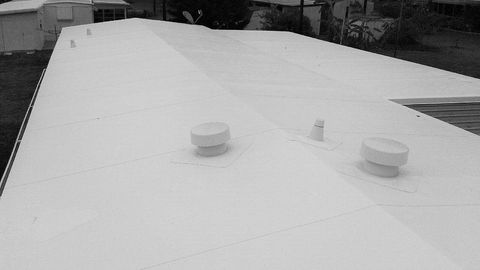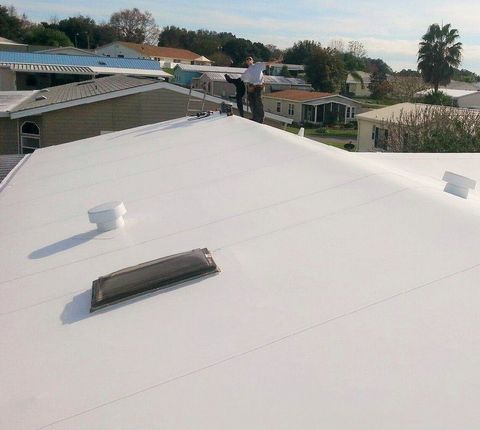About US
We've been proudly roofing since 1985.
Comfort CoverSystem's goal is to improve the service of re-roofing with
honesty,
quality and most importantly,
good service!
The Mobile Home Market
Manufactured housing makes up 25 percent of the residential market in the Sunshine State, the majority found in the roughly 2,700 mobile/manufactured home communities with 50 or more dwellings. Being relatively inexpensive and requiring little maintenance, mobile/manufactured homes are ideal not only for the huge population of Florida retirees, but also for young families buying their first homes.
According to the Manufactured House Institute, manufactured homes cost anywhere from 25 to 50 percent less per square foot than traditional site-built homes. They’re much more efficient than site-built housing to assemble, and their construction quality can be surprisingly good, with factory control of key elements such as materials, fixturing and indoor weather conditions.
Message Us
* INDICATES REQUIRED FIELD
Contact Us
We will get back to you as soon as possible.
Please try again later.
A Tough Environment For Roofing
Unfortunately for mobile/manufactured home dwellers, indoor factory weather quickly disappears under the hot Florida sun. For it is this brutal sun - not tornados - that more commonly gives mobile/manufactured home owners trouble. While posing less physical danger, the sun can make life very uncomfortable and cause energy bills to soar. No part of a home sees more beating sun than the roof, which is why Florida is regarded as the most severe roofing environment in the U. S.
The need for increased protection from the sun is not lost on Florida roofing contractor Bob Mays of Comfort CoverSystems, Inc. in Clearwater. His patented roofing system has been used extensively in Florida since the mid 1980’s, not only on mobile/manufactured homes, but also on similar structures such as aluminum roof additions and low-slope gravel roofs on conventional homes.

Years of Testing Provides Solution
Mays first worked on methods of insulating mobile/manufactured home roofs in 1978, while employed by an insulation company. “We eventually found that the best and quickest way of insulating roofs was to install a layer of insulation over the current roof, and then cover that with a single-ply membrane,” he reports.
At first, fiberglass batt insulation was used under the membrane, but problems quickly developed. Explains Mays: “Up north, we found that snow loads compacted the batt insulation, and after six or seven snows, the system broke down. We’ve since used a variety of insulation boards, including EPS and polyisocyanurate.”
In 1985, Mays received a patent on his current system, consisting basically of a single-ply membrane mechanically fastened over rigid, foil-faced insulation board, and finished around the edges by a termination bar.
Membrane Beats the Elements
Mays found that the durable single-ply membrane provides maximum protection and ease of application, while offering a reflective white color that helps reduce energy costs. Over 400 million sq. ft. of this membrane has been installed worldwide, with 20 million sq. ft. used successfully in Florida.
“Our shop assembles the membrane into custom-sized panels to fit each home. After we install the insulation, it’s merely a matter of rolling out the membrane panels, mechanically fastening them to the deck, and securing the membrane around the edges of the home using a termination bar.”
The Comfort Cover Systems’ mobile/manufactured home roof-over system was developed for quick, economical installation over virtually any existing manufactured home roof. The white membrane reflects 78 percent of the sun’s heat-producing rays, providing immediate savings on air conditioning bills. In fact, the single-ply membrane is qualified by the EPA as part of the “ENERGY STAR” products program. “We’ve had very good reaction to this system,” reports Mays. “We’ve found that customers with older homes can save up to 50 percent on their energy bills over a year’s time. Even on newer mobile/manufactured homes, typical savings are about 30-35 percent.”
The single-ply membrane, developed with an advanced thermoplastic polymer provides exceptional resistance to the worst heat and UV rays, rain, wind, salt exposure and contaminants and other pollutants. The single-ply roofing membrane has outstanding durability and weatherability, and allows it to retain its physical properties over time. The membrane stays flexible without becoming brittle or cracked.
Roof-over “Better Than New”
“I tell people that when we roof-over, the roof we install is better than their original roof when it was new, and I can back up that statement,” says Mays. “For one thing, the galvanized steel (standard .028 thick), manufacturer-installed roofing on most mobile manufactured homes requires that a coating be applied every year or two, to keep it from deteriorating very quickly. Using our system, this cost is eliminated.”
Another drawback of the metal roofs installed by mobile home manufacturers is “roof rumble” - the noise made when wind passes over the roof, causing it to vibrate. Trying to stop roof rumble by weighing down the roof with cement blocks or tires can cause more trouble than the noise itself. And while “rumble buttons” - large washers screwed through the metal roof and into the rafters - can be a short-term solution, they can tend to work loose and cause leaks because of the expansion and contraction of the metal roof. An insulated, single-ply roofing system is quiet and effectively eliminates roof rumble.
Many of the newer double-wide mobile homes use shingle roofs. But these also can fail early, especially when manufacturers use only a single layer of shingles, instead of two or three layers found on a conventional site built home. According to Mays, a single course of shingles often is used on a mobile home because of second layer of shingles would add too much weight to the structure. After time, the edges of the shingles curl, stiffen and even break, allowing wind-driven rain under the shingles. “A low-slope roof with just a single course of shingles can’t stand up to the great amount of ultra-violet light and heat in Florida,” he says.
A single-ply mechanically attached Comfort CoverSystems’ roof installs right over the existing roof, providing a lightweight roof cover that is well within the weight limits for mobile/manufactured homes.
The alternatives - increasingly frequent re-coating of the original metal roof as it deteriorates, or more expensive tear-off and re-shingling or roof-over with a metal roof - simply don’t offer the home owner the same value and convenience as a relatively low cost, single-ply roof-over.
Additional Single-ply Advantages
“Unlike metal roofing systems, we’ve found the single-ply system is very easy to put down,” says Mays. “We make up most components in the shop, and when we get everything out to the site, we can complete the job in one day - maybe 5 or 6 hours. Besides saving time, which means less labor cost, we also give the customer less noise and disruption. We come in, put on their new roof, and we’re gone.
For homeowners who’ve ever experienced the lawn-clogging debris of tear-offs, the ear-pounding hammering of re-shingling, or the costly multi-day installation of a metal roof-over, Comfort CoverSystems’ offer can be quite attractive. As part of its roofing package, the company also replaces all vents, plumbing stacks and range hood vents with new aluminum vents, giving homeowners an entire new roof system.
"A big reason people choose to live in mobile/manufactured homes is because it eliminates a lot of the care and expense of traditional homes, “ observes Mays.” A lot of that benefit is lost if they’re constantly having to re-coat their roofs and having leaks fixed. Choosing a Comfort CoverSystems’ roof-over not only cuts their energy costs, it also gives them a long-lasting, carefree, maintenance-free roof.”

Copyright © 2024 comfort cover roofing All Rights Reserved



